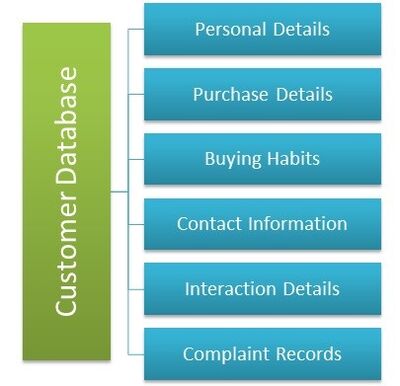Customer Database
A customer database is a collection of information that includes lead contact details like a person’s first and last names, phone numbers, email addresses, etc. It can also include the following data:
- Demographic characteristics: age, gender, marital status, household composition
- Profession-related characteristics: job position, mutual contacts
- Buying behavior: shopping preferences, past purchases, the average sum of bill or invoice, previous cancellations
- Firmographics (for B2B clients): industry, number of employees, ownership, etc.
How complete your customer database is depends on your goals, the type of data you collect, the leads you have, and how your company is going to use this information. Descriptive fields for unqualified leads and loyal customers may differ significantly. While the first ones can consist of only name, email, phone number, and gender, the second ones can include more substantial information. Say, the address, information about kids/spouses/parents (if any), previously ordered goods, or the responsible account manager’s contacts.[1]
Why Build a Customer Database[2]
As online sales increase in frequency, making the most of the online traffic will be crucial for driving your business forward. By focusing on building a customer database, you’ll gain valuable insights about your customers to then leverage into sales decisions. For example, you might find that one of your products is particularly popular with the 18-29 year-old age group. You could then look to promote the product with links to buy it on social media where younger consumers are more likely to visit. The database insights will give you a clearer plan for upselling and improving your business performance.
A customer database also provides an opportunity to build rapport with your customers. You can inform them on product updates, new services, and communicate your strategies to keep them informed. It also offers an opportunity to show your human side, interacting with your customers and showing them that you care. Effective and honest communication leads to loyalty and brand affinity — just be careful not to spam your customers.
Importance of Customer Database[3]
With more emphasis towards the use of statistical techniques, methodologies, and applications to develop models of customer behavior, attitudinal data, business patterns, future forecasts, and decision making marketers tend to be heavy users of customer Databases. Business Intelligence tools help to enhance business operations with interactive access and manipulation of data. A customer database, which is an internal database, is usually preferred than a data warehouse for marketing purposes as a data warehouse can contain a large pool of unstructured information which is irrelevant for marketing purpose and requires additional business intelligence tools for analysis. Database marketing helps target the right customers at the right time. However, a customer database carries only the relevant information in a structured format which can be retrieved or analyzed using simple queries or minimal business intelligence tools.

